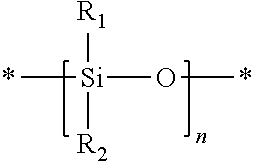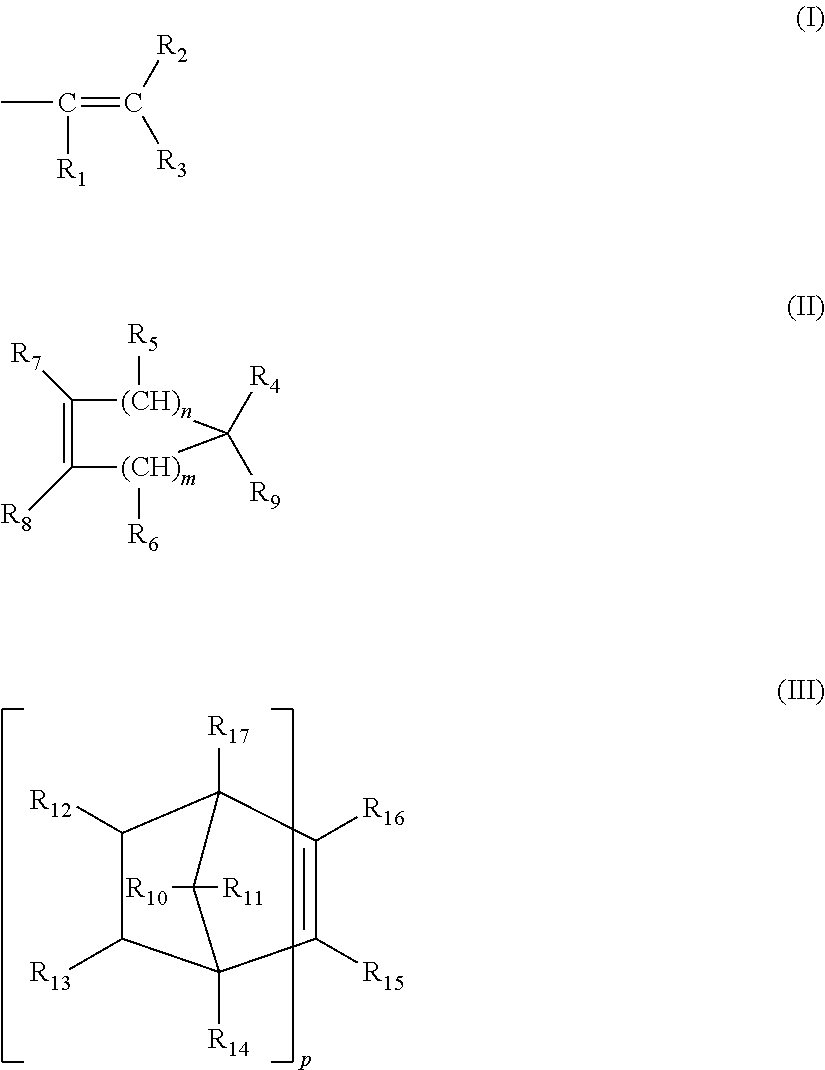Silicone-containing prepolymers with dangling hydrophilic polymer chains
a technology of hydrophilic polymer chains and silicone hydrogels, which is applied in the field of soft silicone hydrogel contact lenses, can solve the problems of corneal swelling, inability to easily circumvent oxygen, and undesirable growth of blood vessels in the cornea
- Summary
- Abstract
- Description
- Claims
- Application Information
AI Technical Summary
Benefits of technology
Problems solved by technology
Method used
Image
Examples
example 1
Surface Hydrophilicity (Wetability) Tests
[0196]Water contact angle on a contact lens is a general measure of the surface hydrophilicity (or wetability) of the contact lens. In particular, a low water contact angle corresponds to more hydrophilic surface. Average contact angles (advancing) of contact lenses are measured using Wilhelmy Plate method.
Coating Intactness Tests
[0197]The intactness of a coating on the surface of a contact lens can be tested according to Sudan Black stain test as follow. Contact lenses with a coating (e.g., an LbL coating, a plasma coating, or any other coatings) are dipped into a Sudan Black dye solution (Sudan Black in vitamin E oil). Sudan Black dye is hydrophobic and has a great tendency to be adsorbed by a hydrophobic material or onto a hydrophobic lens surface or hydrophobic spots on a partially coated surface of a hydrophobic lens (e.g., silicone hydrogel contact lens). If the coating on a hydrophobic lens is intact, no staining spots should be observ...
example 2a
Synthesis of Intermediary Copolymer (YS-3203-028-1)
[0206]A mixture of 60.0 g of αω-bisacrylamide-polydimethylsiloxaneM.W.≅11,500, and 241.6 grams of 1-propanol is added to a 2-L heating / cooling jacked reaction vessel equipped with mechanical stirrer, condenser, vacuum / N2 connection, thermostat. The solution is chilled to 8° C. and degassed for 3 cycles of evacuation to 15 mbar for 15 minutes and flushed with N2. The system is controlled under nitrogen environment until the end of reaction. The monomer solution which contains 25.83 g of N,N,-dimethyl acrylamide, 11.07 g of PEG-Acrylate (MM=454), 1.05 g of cysteamine hydrochloride and 140 g of 1-propanol is slowly added to the reaction vessel by a LC pump connected with a degas unit. The adding rate of the monomer solution is controlled at ≅3.0 mL / minute. After all of the monomer solution is added, the mixture is slowly heated from 8° C. to 68° C. over an one hour time period. When the polymerization temperature reaches 68° C., the in...
example 2b
Synthesis of Prepolymer
[0208]The purified emulsion solution from Example 2A is diluted to ≅2 L and then charged to a 2-L heating / cooling jacked reaction vessel equipped with mechanical stirrer and thermometer. A buffer salt, 4.0 g of NaHCO3, is added and then mixture is cooled to 0° C. The solution pH is adjusted to 9.5 with 20% NaOH(aq) and then start adding 5.8 mL acryloyl chloride over 2 hour followed by another hour of agitation. The solution pH is controlled at 9.5 during the acrylation by a static pH control equipment with 20% NaOH(aq). After the reaction is completed, the solution pH is adjusted to 7.0 with 2N HCl(aq) and then purified by ultrafiltration using a membrane with 10 KD molecular weight cut off. The purified emulsion is freeze dried and yield a while solid.
PUM
| Property | Measurement | Unit |
|---|---|---|
| water contact angle | aaaaa | aaaaa |
| molecular weight | aaaaa | aaaaa |
| molecular weights | aaaaa | aaaaa |
Abstract
Description
Claims
Application Information
 Login to View More
Login to View More - R&D
- Intellectual Property
- Life Sciences
- Materials
- Tech Scout
- Unparalleled Data Quality
- Higher Quality Content
- 60% Fewer Hallucinations
Browse by: Latest US Patents, China's latest patents, Technical Efficacy Thesaurus, Application Domain, Technology Topic, Popular Technical Reports.
© 2025 PatSnap. All rights reserved.Legal|Privacy policy|Modern Slavery Act Transparency Statement|Sitemap|About US| Contact US: help@patsnap.com



